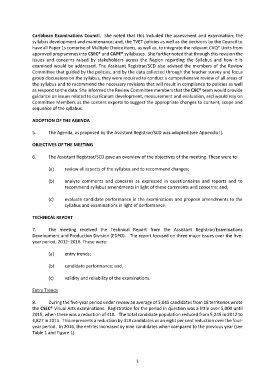Page 1375 - SUBSEC October 2017_Neat
P. 1375
Caribbean Examinations Council. She noted that this included the assessment and examination; the
syllabus development and maintenance; and, the TVET policies as well as the decisions by the Council to
have all Paper 1s comprise of Multiple Choice items, as well as, to integrate the relevant CVQ* Units from
approved programmes into CSEC® and CAPE® syllabuses. She further noted that through this revision the
issues and concerns raised by stakeholders across the Region regarding the Syllabus and how it is
examined would be addressed. The Assistant Registrar/SCD also advised the members of the Review
Committee that guided by the policies, and by the data collected through the teacher survey and focus
group discussions on the syllabus, they were required to conduct a comprehensive review of all areas of
the syllabus and to recommend the necessary revisions that will result in compliance to policies as well
as respond to the data. She informed the Review Committee members that the CXC® team would provide
guidance on issues related to curriculum development, measurement and evaluation, and would rely on
Committee Members as the content experts to suggest the appropriate changes to content, scope and
sequence of the syllabus.
ADOPTION OF THE AGENDA
5. The Agenda, as proposed by the Assistant Registrar/SCD was adopted (see Appendix I).
OBJECTIVES OF THE MEETING
6. The Assistant Registrar/SCD gave an overview of the objectives of the meeting. These were to:
(a) review all aspects of the syllabus and to recommend changes;
(b) analyse comments and concerns as expressed in questionnaires and reports and to
recommend syllabus amendments in light of these comments and concerns; and,
(c) evaluate candidate performance in the examinations and propose amendments to the
syllabus and examinations in light of performance.
TECHNICAL REPORT
7. The meeting received the Technical Report from the Assistant Registrar/Examinations
Development and Production Division (EDPD). The report focused on three major issues over the five-
year period, 2012–2016. These were:
(a) entry trends;
(b) candidate performance; and,
(c) validity and reliability of the examinations.
Entry Trends
8. During the five-year period under review an average of 5,045 candidates from 18 territories wrote
the CSEC® Visual Arts examinations. Registration for the period in question was a little over 5,000 until
2015, when there was a reduction of 418. The total candidate population reduced from 5,245 in 2012 to
4,827 in 2015. This represents a reduction by 418 candidates or an eight per cent reduction over the four-
year period. In 2016, the entries increased by nine candidates when compared to the previous year (see
Table 1 and Figure 1).
3

